Do you need pectin to make jam? I used to think so.
I followed the recipe on the inside of the pectin box slavishly for 7 years before I broke free of the pectin bonds. Every year, my strawberry jam tasted exactly like the strawberry jam of everyone else who wore the Sure-Jell shackles. The jam was never bad, but it was never really mine, either.
Before, jam making was about following rigorous and strict recipes, adding in a ton of sugar to “ensure a good set,” skimming diligently to remove foam and crossing my fingers while timing that one minute of “hard rolling boil” down to the second. That’s what was required by the pectin box master and I was terrified to change a thing lest I ruin an entire batch of jam.
Now, I’m a liberated pectin-free jam maker, and I’d never go back.
When I make preserves now, I work with my fruit, tasting and adjusting things like sugar and spice based on fruit ripeness and variety and juiciness and what sounds good. I reduce water out of my preserves to get the consistency and depth of flavor I’m looking for. I reduce sugar levels down to one-forth or less of typical levels and still produce a preserve that is full of sweetness and sunshine. My jams, each and every batch, are creative and unique.
The only things I slavishly adhere to now are sanitation and processing standards, and acidity levels, which ensures that while I’m having fun and getting to be creative jam-girl, I’m also producing a product that is faultlessly and impeccably safe for my family and friends to enjoy.
Here’s how I make high-acid fruit preserves. All photos in this series are from a batch of Apricot Jam with Lime, Ginger and Tequila that turned out so good I said, “Sweet baby Jesus!” upon tasting it. Except I pronounced it “Jesús” in the Spanish way. You know, in honor of the tequila.
As I mentioned in yesterday’s post, I think of the flavorants I add to my preserves as either “Dry Zing” or “Wet Zing” because they add that zing of flavor I’m looking for and they are either dry (herbs and spices) or wet (boozes, extracts, vinegars, etc.). If you missed it yesterday, you can download a Flavor Maker Chart of Wet and Dry Zing suggestions for all the fruits I typically jam on the Downloadables page.
Basic Pectin Free Preserve Formula
makes about 4 half-pint jars of preserve
- 2 pounds washed and appropriately prepared fruit (Peel, seed, chop, etc. Weigh after preparing.)
- 4 to 8 oz (a gently rounded ½ to 1 cup) organic sugar
- 1 tablespoon freshly squeezed lemon or lime juice
- ¼ teaspoon Dry Zing (optional, see Flavor Maker Chart for suggestions)
- 1 tablespoon Wet Zing (optional, see Flavor Maker Chart for suggestions)
Method
For every 2 pounds of prepared fruit, add 4 oz. sugar (a gently rounded half-cup is 4 oz.) and combine in a large bowl. Scale as necessary; I usually do 6 pounds fruit and 12 oz. sugar, which gets me about 10-12 half-pint jars of jam, depending on how much I reduce the jam. Cover fruit-sugar mixture and transfer to the refrigerator to macerate. Let sit overnight, or up to 24 hours.
In truth, I’ve left my sugared fruit for a few days in the fridge and there’s never been any harm done. That’s another reason I like this method. Sometimes it’s very nice to be able to put fruit “on pause” for a day or two until you can get it in a jar.
After 12-24 hours, the sugar should be mostly dissolved and the fruit should have released quite a bit of juice.
Prepare jars and lids as for standard water bath canning. Keep spotlessly clean half-pint or pint jars warm in a large pot of simmering water. Have new lids and clean bands ready. Have a clean lint-free towel or paper towel available to wipe jars. If you are new to water bath canning, I recommend you read this to get a feel for the basic procedures and precautions you must take to ensure you are creating a safe product.
Transfer the fruit, sugar and all the juices to a large, very wide, shallow pan. Something like a huge saute pan is good. You want as much surface area of the preserve exposed as possible to allow for the fastest evaporation of excess water from the preserve. If you have more fruit than you have pan, divide your fruit and juice as evenly as possible among pans, or work in batches.
Bring the macerated fruit and juices to a simmer over medium heat. Stir frequently, you do not want your fruit to scorch.
When your fruit has softened but not fallen apart, add in your lemon or lime juice, 1 tablespoon for every 2 pounds of fruit initially prepared.
Also add in your Dry Zing component, if using. Use ¼ teaspoon for each initial 2 pounds prepared fruit unless you are using a really potent spice like cloves. Then use less. Stir.
At this point you have to decide what kind of texture you want your preserve to have. If the texture in the pan is too chunky or the pieces are too large, crush your fruit with a potato masher or puree as desired with an immersion blender. I like a quite chunky texture but this is entirely personal.
Take a small spoon of preserve, including some fruit and a bit of syrup together if your preserve is chunky, and taste them. Is your jam sweet enough? Does it need more sugar?
If your preserve is tart at this point, add a bit more sugar, up to an additional 4 oz. (another rounded ½ cup) for every 2 pounds of fruit initially prepared. You may need even more sugar if you are cooking something quite tart, like quince, currants or gooseberries. Trust your judgement. If you think the preserve needs more sugar, add it. If it is sweet enough to your taste, leave it alone. Remember that as you cook the preserve longer the flavors, including the sugar, will taste more concentrated. Stir everything gently but consistently.

When your preserve is glossy, a bit darkened and looks slightly thickened, transfer a bit of jam to a cool (ideally refrigerated) plate. If you run your finger through a dollop of jam on a cool plate and the finger mark remains visible or runs together only very slowly, the jam has reached the soft spoonable stage I prefer.
At this point, add the Wet Zing flavoring if desired, using 1 tablespoon for every 2 pounds of fruit initially prepared. If using a flavor extract, like vanilla or almond, use only 1 teaspoon and adjust to taste. Strength of extracts varies considerably by brand and you don’t want to overdo it. Most of the Wet Zing components have flavor compounds that are quite volatile and should be added towards the end of the cooking time lest their flavor evaporate away.
Stir well, taste jam one last time (clean spoon, please!) and make any final adjustments to the sugar level. You may also add additional citrus juice at this point, if desired. If a preserve tastes like it just needs a little something, usually that something is a few drops of lemon juice. No kidding.
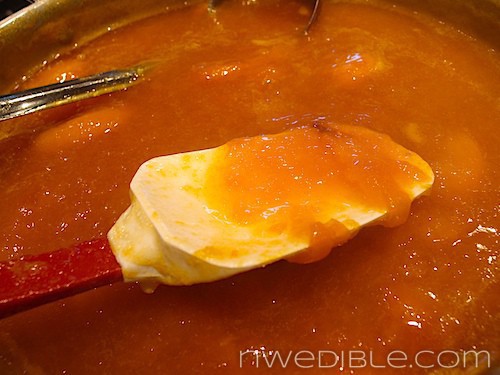
At this point, keep your preserve at a bare simmer and proceed to fill and lid your jars as per standard water bath canning procedure. Remember to wipe the rims of your jars before setting lids! Process half-pint or pint jars of jam for 10 minutes at a full rolling boil.
A word about texture: a jam made in this pectin-free manner will not give you the firm, high mounded spoon look of a pectin jam. The thickness does not come from gelling the moisture in the preserve, but from reducing excess water out of it (this is why using a wide, shallow pan is so important).
Preserves made this way will give you a French-style, soft jam, thicker than syrup or ice cream topping but not so thick as to allow a spoon to stand upright in the jar, as is the case with many pectin-set jams. I find this texture to be more sophisticated, frankly. The depth of flavor and slightly caramelized tones that come from lower water content, longer cooking and reduced sugar content can’t be beat.
And because you are liberated from the chains of the pectin recipe you can have some fun with creating flavors all your own. The only caveat is that your jam, to stay safely water bath can-able, must stay high-acid, with a ph of 4.6 or less.
Have you made pectin-free jam or are you dedicated to the box?
175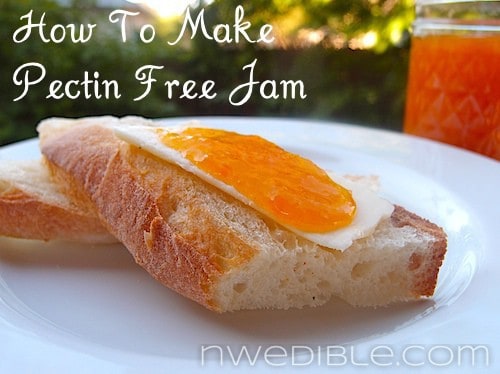
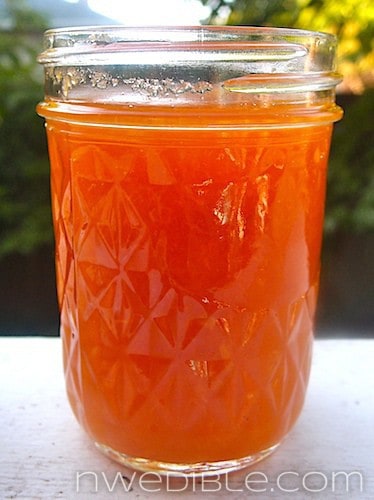
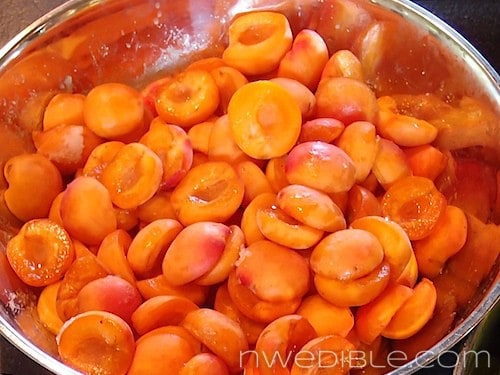
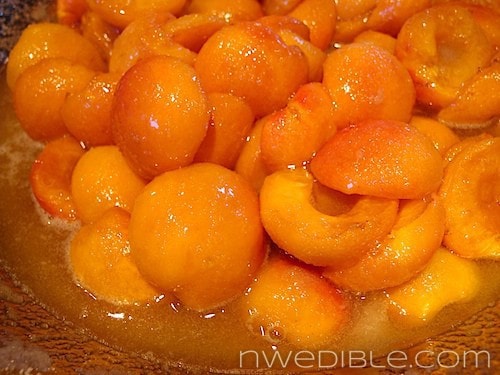
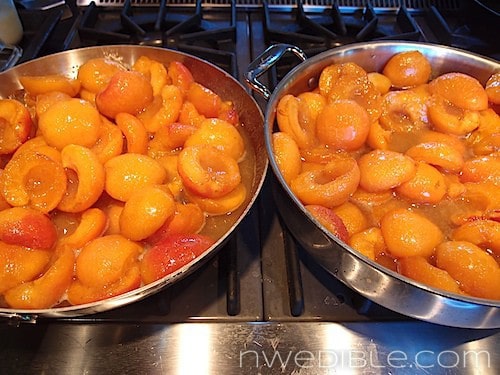
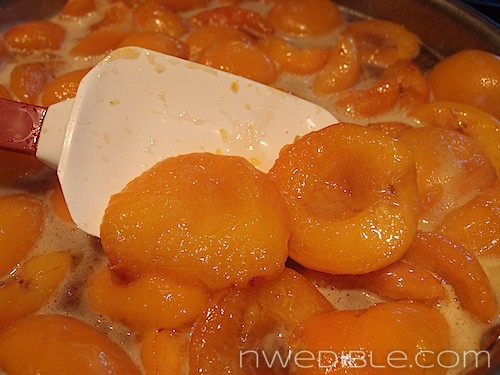
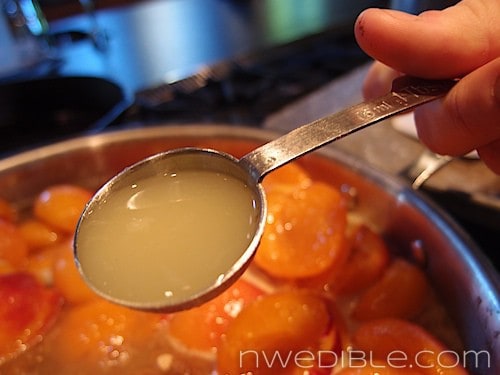
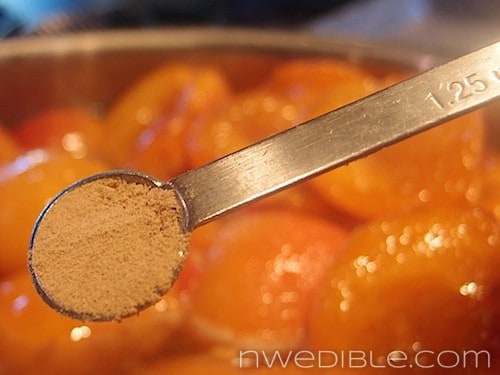
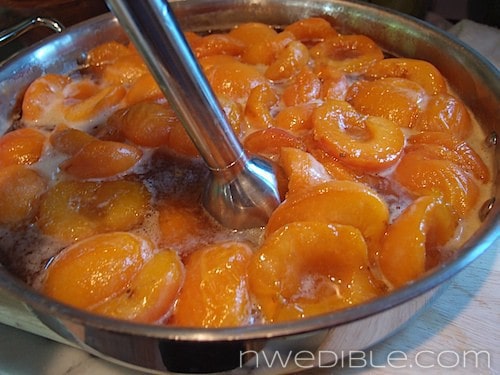
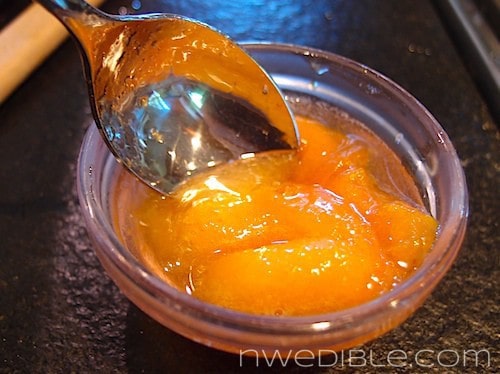
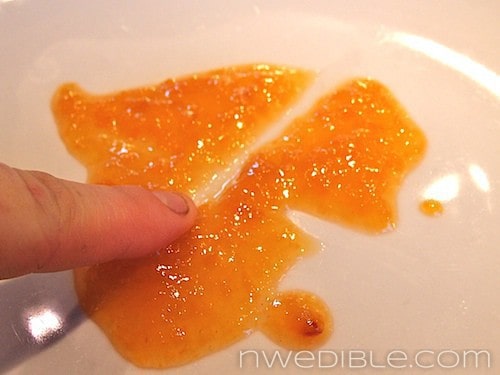
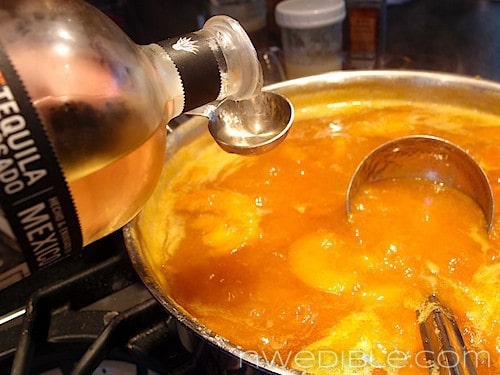
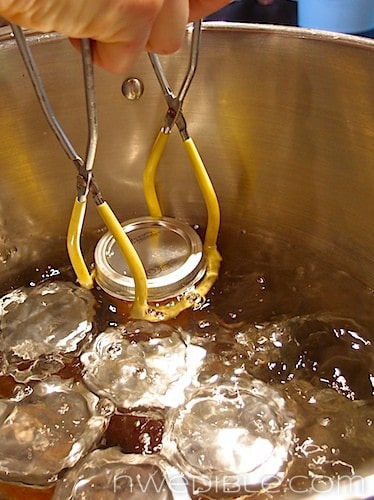
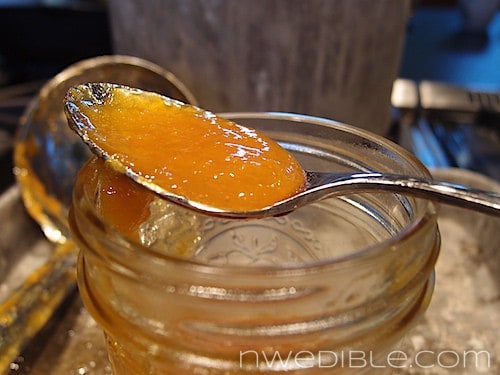


Thanks so much for sharing this post! I just made a batch with nectarines and another with plums. Your instructions and photos were so helpful! I’m wondering if you’ve ever tried making jam with cantaloupe before? Do you think I could try this same pectin-free method with melon? Thanks!
I am so excited to have found his blog. I have just started learning to make jam. My friend that taught me prefers not to use pectin so that is how she taught me. However, she uses a LOT of sugar. I mean 4 cups for every 2 lbs of fruit vs. the 1/2 cup you are recommending. The finished product is good but it is so sweet. Sometimes I feel like I can’t taste anything but the sugar. I am so excited to try this technique.
Erica,
I’m so excited to have found your blog!
I’m a rookie at gardening and canning, but quickly becoming a convert. I used pomonas for my first batches of jam, but love the idea of no pectin at all. Did you peel your apricots? Skipping that would be a huge time saver.
Thanks for all the great information.
Tenesa
That recipe looks delicious. Thanks for posting your discoveries.
On a science note. Your jam isn’t “pectin-free”. It is “added pectin-free”. You are using high pectin fruits and boiling them down to concentrate the pectin and adding acid and sugar to cause it to gel.
I am Australian and I’ve been making jams and jellies for more than 25 years, taught by my mother, aunt and grandmother. I’ve never ever used pectin and get terribly frustrated by American recipes that always use it. I rarely have a problem setting my jams and jellies. There is plenty of natural pectin in fruit, especially if it’s freshly picked and not over-ripe – and lemon juice and sugar help too. I’m really pleased to see more people eschewing pectin in their jam-making adventures.
And I never peel! Wash yes, peel no.
Not to veed OT…because my full intention to to start a few batches this weekend and i’ve been salivating over the fact that I found this blog all week long (it’s all i can think about at work while my peaches sit in the fridge waiting for me!) but….I read that comment as “I never pee” before taking a few more looks at it…..:):):)
My first ever jam batches – I was lucky enough to start pectin-free, but was using way more sugar than this recipe, so have just tried this one out (a fairly standard plum and cinnamon). This wins hands down! Thank you for sharing!
Do you have any suggestions on how to use frozen fruit when making jam? I have a ton of blueberries that my husband and I picked over the summer and he wanted to know if I could make some jam out of them. I didn’t know if the freezing process would change how I have to treat them when making jam, or if it is even a good idea to use frozen berries.
I’ve used frozen berries before with no problems. I just let them thaw and then followed the recipe from the pectin box- delicious, though very sweet. I haven’t tried making jam without pectin yet, but I’ll bet it would work, too!
Thank you so much for the jam making tips!
THANK YOU for your Signature Jam Flavor Maker Chart. Hot damn, what a fantastic resource! I’ve tipped, I thank you, and I will tell the world of your brilliance.
I just made the most beautiful pawpaw / papaya jam using the techniques you described in your blog. Thank you very much for sharing.
I use the box, but mainly because canning is something I have not yet invested in, so I stick to freezer jams. If we invest in jars, lids, and a water bath canner, I look forward to experimenting with more jams!
Thanks!!! Love this post.
I love the idea of this tailor made jam recipe. Unlike you, I ‘ve never used pectin,that is, until today, because I wanted to try low sugar jam. I didn’t care for the result, and agree with you that softer set jam is more sophisticated, so I searched for a low sugar, no pectin recipe and found your blog. I can’t wait to try this with my glut of strawberries.
hello, do you have any recipe for fig jam? i have lots of figs from my trees so i don’t want them go to waste. I need a recipe that lasts me the whole year 🙂 Thank you!!! 🙂
This is my basic fig jam recipe, with inversion canning technique:
Fig Jam
5 1/2 Cups chopped juicy ripe figs (black mission is great)
2 – 2 1/2 Cups sugar
1/2 Cup lemon juice
Boil, stir, mash, and fill hot/sterile jars (clean jars are placed in 250 degree oven for 20 min before filling).
Clean lids in boiled water, then screwed on and jars inverted for 5 minutes.
i’m so happy to find this site and just prepared some plums and apricots to macerate till I can make some jam tomorrow. 2 separate batches and then one i’ll combine into my own homemade pluot. question about doing this with peaches or nectarines as they often turn brown when sitting without some lemon juice. does the sugar prevent the browning or should I just not worry about that.
I stumbled on your website this week looking for something tasty and healthy to do with an overabundance of strawberries a client brought by.
Having never made jam or jelly before I was a little, ok…a lot, concerned that I would end up creating some horrible nasty tasting gloppy mess.
Not so at all. To my amazement I ended up with a tasty (or so my co workers said after scarfing it up on homemade strawberry bread and by the spoonful) actually jelly looking jelly with no nasty additives. I’m already getting requests for different flavors. The wild blackberries along the fence are ripening nicely so I think that will be my next venture.
Thank you so much for your wonderful easy to follow instructions! I think I’m becoming addicted to your blog.
Just found your blog and I cannot wait to try some of your canning recipes! Just wanted to put in my two cents about Pomona’s pectin, as I can’t recommend it highly enough. It is basically fool-proof for beginners and provides great flexibility with sweetener amounts (I prefer a low-sugar jam). I have not found it to be jello-y, as one commenter mentioned. I want jam that doesn’t squirt out of a sandwich and that is firm enough to stand up in jam bars or between cake layers–the looser preserves tend to soak in too much when used in cakes/baking. I stopped making jam altogether after ruining several batches of expensive berries with traditional pectin. I would note that low-sugar jams don’t last quite as long in the fridge, once they’ve been opened. One more tip: when making peach jam, I puree the skins and add them back to the jam mixture to get a more assertive peach flavor–it makes the jam a bit less translucent, but is totally worth it.
I can’t tell you how long I’ve been searching for something like this. What a great tutorial. Thanks so much for posting this!
You are using very very low amount of sugar in your jam. I calculated it about 11%-22% (2lb. of fruits 909g with half cup of sugar 100g to one cup of sugar 200g). I’m wondering how long it can be kept in the can (jar) outside the fridge. And how runny is your jam?
I never try making my jam with less than 25% of sugar to the weight of the fruits before. 25% is al my bottom line. I normally used between 25-50% of sugar weight to the fruits weight (after processing, such as hull, pitted and etc.) and some of my jams are already too runny due to not enough sugar to strengthen the pectic net. I kept it that way because I like the taste but I can’t use it to make cookies, chocolate filling and etc as the way I usually use. I have to keep it for jam only.
BTW: Envy at your garden! I wish I have green thumbs.
Great blog!
Great post. I converted from pectin to non-pectin jams last summer, and I’ll never look back again either. I’ve had way more fun combining flavors, and the amount of sugar in my jams has dropped significantly, because with fresh, ripe fruit, I’ve found I don’t need it. I’ve been really enjoying reading your other posts as well, by the way – great job on creating an interesting blog!
Great blog, recipes, comments! I never really saw a response to the few questions about freezer jams, though. which I’m doing as we speak….basicially using the above recipe, boiling ‘way down, then going to toss into sterile jars, leaving headspace, cool a bit, then freeze. Do you see any problems with that, safety-wise? I expect it’ll be eaten within half a year. I know part of the reason to do freezer jam is no-or-barely cook, but another reason is it’s easier looking to a guy whose never made jam or canned before…but, wow! does it look great right now!
Can’t wait to try this recipe. Impressive instructions. I’m curious…can you freeze the jam like freezer jam instead of can using this method? I like making freezer jam so much better.
This post was so liberating! Just like you described, I was a slave to the box when I first started ( I’ve only made about 6 batches of jam and jelly so far, but plan to do tomatoes and pickled jalapenos when I have enough!)- the box said Don’t double the batch! Don’t decrease sugar!! Boil for 1 min only!!
The strict rules made canning scarier, and my jams boring and oversweet. It is so much less stressful to just cook it down until it gets thick enough (until it sheets off the back of a spoon), taste until it is sweet enough, etc. And I love macerating it overnight in the fridge- less work on canning day. Thanks so much for the post!
I found this wonderful post as I was staring at a batch of raspberry jam thinking it just needed something… lemon juice to the rescue! Thanks!
Hi!
I tried this method today using cherries from my yard. So far, so good! I wrote about it on my blog, and I linked to you. Thank you so much for the wet/dry zing resource! I’m really excited about doing more with this.
I recently came across a book by Karen Solomon in which she has a recipe for making your own pectin from apple cores and peels. I really want to try it. Have you ever done this?
Thanks so much for the pectin free and low sugar info. Our strawberry and raspberry jam this year is out of this world – heavenly. I added just a touch of local maple syrup to both as a wet zest.
Hi! Thanks for the great ideas. I kind of read the wet ingredients wring on the vanilla in my cinnamon vanilla peach with brown sugar and it’s quite vanilla-y. I’m trying to think what to pair it with that will be fabulous. The flavors meld; there’s just too much vanilla. Maybe graham cracker and some sort of cream cheese-type layer? The ginger-peach-cointreau was FAB and the Just Peach was insane. (Should have thought my way through superior fruit= needs less to dress it up. Oh well, it’s still good. )
I’ve always used less sugar because I used the no/low sugar pectin… but now it’s $4 a box. Thanks, but no thanks. When the homemade jam is more expensive than the store stuff, you start thinking twice. This no pectin stuff is rockin’ my world!
Teresa
I am in love!!! Made my “crutch” batch of peach pectin freezer jam to be sure that I had some that was ok…then I went for your recipe! I just finished a peach and cinnamon which tastes like a fantastic cobbler as a jam. Not too sweet (which is my usual issue with pectin jam) and a wonderful texture. I skinned the peaches and I’m now wondering if I shouldn’t try a batch with the skins on and just zip it all through my vitamix at the appropriate time…. I am on a jam adventure for sure. Thank you!!!!!
I’ve never canned or made jam before, but my mother and I are about to make some plum jam with your method. Both of us are sugar sensitive, so we prefer not to use a lot of sugar. Your recipe is nice for that and so many other reasons. Plus, we get to use all the gorgeous plums from our very own plum tree!
Greetings Erica,
I’m a newbee to this site also and am loving it. I just started a little, very little, business of selling my jams and marmalades. I have never used pectin thus far and would only use it if absolutely called for. I do have a question though. I made some peach jam last week and just before putting it into sterile jars, I tasted it and it tasted just perfect. I always save a bit of jam so I c an taste the finish product after it cools. Lo and behold, my peach jam desperately needed more lemon juice. So I reprocessed it. A real pain to do so but had to be done and now it’s delishious. I’m inspired by your creativity and firm convictions. Thank you for this blog. I’m signed up and will be following along. If you have an answer regarding tasting while hot not really being reliable, please get back to me and/or post for all to see.
Making Apricot jam the new way and adding Vanilla. Fingers crossed. There are many who are waiting for this and I don’t want to disappoint.
I love reading the posts and woulld also love reading the replies.
I just thought I would write a brief note of thanks… I just picked two coolers full of sour cherries and will definetely try this type of jam making… cloves and cpt. Morgan sound like good options to dry I think. Thanks again. 🙂
As a former home economics teacher I’m delighted to find so many people interested in preserving! This is a marvelous site. In reviewing most of the comments, I don’t see anyone who has mentioned the old sealing version of using melted paraffin wax. It is what I grew up with many years ago and still use. Main concern is that one checks to make sure that the wax is totally connected to jar edges and solid surface. This method means you don’t have additional heat once you have achieved the desired thickness. Thanks also for the Zinger Chart. Many of these are old favorites – some that I must try next!
Funny that paraffin should come up right now. Just yesterday I was reading about jam making and it seems that the problem with paraffin is that it is not safe from mold and other beasties.
Fantastic post, thorough instructions, delicious results- my plum-vanilla jam was just pulled out of the water bath and is popping away on the counter. Thank you for the time and effort you put into this post (and all your others!). Looking through the previous comments, I’m clearly not the only one who feels liberated form store-bought pectin. I fully enjoyed this relaxed, stress-free way of making jam. Thank you!
Wonderful and informative. Have my strawberries macerating in the fridge at this very moment. Was just wondering what the difference will be from boiling down right away and macerating overnight but liked your blog so much thought there had to be a good reason. Can you please enlighten me? Thank you! Kris
Hi! I just wanted to let you know… this blog post was literally life-changing for me… lol at least my jam-life, anyway! I am so glad to be free of “the box” and free to experiment a little, instead of sticking to the stock recipes right to the letter. 🙂
A followup…. I have been using your general approach and your “zing” inspirations to create some jellies as well, so far with great success! The trick is to reach the needed temperature, depending on altitude, so for us it is about 218 F. It doesn’t make as much jelly as I would get through the normal routine of loads of sugar and pectin – I am only getting about half as many jars. Which is kind of a drag in a way, but what I am coming up with is yummy!!
Thanks for this post!! I made 4 BIG batches today: plain Peach, Ginger Peach Brandy, Cinnamon Peach, and Nutmeg Peach, and they are all FANTASTIC!!! Thanks for the great tutorial!
Great site! I used a similiar technique last year for black rasberries and for the wet zing used cabernet!!! It was so good i didn’t want to give any away. Tomorrow i’m going blackberry picking so i will try another combo ALONG with my cabernet since everyone is clamouring for it again!
Great article! My dad always makes pectin free jam without canning, but its quite sweet, always wanted to find a low sugar method sans added pectin. I have a few questions. How long can you keep a jar on the shelf, and how long does it last once opened? Also, approximately how long are you cooking the fruit? Thanks 🙂
I just stumbled on this blog and its beautiful! I’m pretty picky about blogs but I see value here. I just made this recipe today. Cherry, cinnamon and bourbon, it was really perfect. We just bought 12 acres in our state and I will be using your blog to help me keep things organized and progressing, thank you for the inspiration!
I have a problem that I hope someone can help me with. I’ve only been canning for a couple of years and only had one excursion into jam making, because the amount of sugar in standard recipes horrifies me! I’m so happy to finally find someone who is confident about the safety of substantially reducing sugar in the recipe! But yesterday I tried making blackberry jam, keeping it very simple with 4lb blackberries, 8oz sugar, and 2 generous Tbs fresh squeezed lemon juice. I followed the directions here but it would not gel. I gradually added another 30z sugar hoping that would help it, and I ended up cooking it down to pretty much the pulp with no “set” in sight! So now I have canned blackberry sauce 🙁 What did I do wrong?
hi Jo,
I am like you, relatively new with canning this way and found the same problem with my strawberry jam, it was just not jelling up. In fear of over cooking it to death, I grated about 1/3 of a granny smith apple into it about 20 minutes into the cooking and that seemed to do the trick. Of course, this method will never produce the hard jelly of store bought, but will be a softer (saucier if you like) version, which I like better. If your blackberries are too runny you can use them on ice cream. If you are used to store bought this may seem too runny, but you will get used to it especially when you appreciate the difference in flavor.
Hope I have been helpful and answered somewhat your question, don’t think Erica comes by this posting any longer. Kris 🙂
Thanks for responding Kris, yes I noticed that Erica hasn’t responded to posts lately but I was hoping someone would! An apple was all I could think of too, and I guess I’ll do that next time. But I think it affects the flavor and I thought this recipe worked without additional pectin – although using an apple is waaay better than using the commercial pectin! Just wondered if I had done something wrong. Thanks for the support … and I’ll still enjoy my liquefied blackberries!!
Another issue is if you used really ripe fruit. Ripe/over-ripe fruit has less natural pectin, so next time either make sure to have some underripe berries or apple in the mix, or just plan to make homemade berry syrup. Yum!
I’ve seen this technique often lately, of macerating the fruit before cooking it. I haven’t tried it because I’m too impatient! but I’m wondering if it’s worth doing. Do you find the maceration process boosts flavor? shortens cooking time? Maybe I’ll do some experimenting with my next batch of jam.
Thank you for this post! There is a lot of great info here.
Thanks for the great post! I just made some blackberry jam with cardamom as a dry zing and the small amount I set aside in the fridge is setting up beautifully. I cannot wait to explore the rest of your site now!
Thank you Erica for the info; I was raised in Chile where my mother follows a general recipe that is by weight. One kg of prepared fruit to three quarters kilogram of sugar. PECTIN had not been invented then. Just like you, she let the fruit and the sugar mix flavours overnight or up to one day. If it had to be more, she would boil the fruit with the sugar and then back in the fridge once cool.
The fruit sugar mix is then brought to rolling boil for a minute and low boil for 20 minutes, then one can start testing doing the cold dish test, just like you suggest. When you boil fruit for 20 minutes or more, you can start with chunky fruit and you will still have some pieces at the end – marmalade as opposed to jam.
We have never used the hot water bath. I put my clean jars in an oven set at 325 degrees farenheit; I boil the rings and caps and pull them out and dry them just before use.
Once jam jar is filled to within a half inch of the top, I cap the jars and I then put the rings on being careful not to touch with my bare hands (for one thing I would get burned). As the jars cool, I hear the ping of the caps. I have never had any jam go bad on me to this date.
My mothers advice always was: your jam is only as good as the fruit you start off with. This year, for the first time I made apricot marmalade because someone in my local market (Ottawa, Canada) was selling apricots that were absolutely delicious – the jam turned out superb, best ever! just like the fruit I started with.
Anyways, thanks again for a great blog; inspires me to go looking for good fruit to make jam for the winter and to share with friends.
okay…..i just finished a batch of this no pectin jam….i’m not sure i’m a fan, but i really want to be…i love the idea of letting the flavor of the fruit come through more than pectin jam and i love using less sugar…but…we made a batch of pectin jam first and then a batch of the non pectin jam today…the pectin jam made nearly twice as many jars with half the fruit…the pectin jam also took about half the amount of time (or less) because you didn’t have to wait for the liquid to cook out….i really love the consistency of the non pectin jam and the flavor is wonderful, BUT….all that work and only 9 jars from 8lbs of fruit? not sure i’ll do it again….am i doing something wrong? by the way, i did a small batch of the black pepper/balsamic vinegar/strawberry non pectin jam and it was divine!
You aren’t doing something wrong. The cooking out of the water is responsible for both the intense flavor (literally more concentrated) and the lower yield. I normally get about 1.5 – 2 half-pint jars per pound of fruit weighted after trimming and other preparation, but this does vary based on the fruit, ripeness, water content of the fruit, etc. If you were using strawberries that were particularly juicy and really cooked them down, I could see a yield of nine half-pint jars from 8 pounds of fruit as purchased.
Glad to see this answer. This morning I got about 3 half-pints from 3 lbs of (apparently very juicy) strawberries. The jam turned out amazing! It’s good to know this kind of yield is normal.
Hi Guinnivere, Hmmm! what kind of fruit did you make jam with that boiled 8 pounds into 9 jars(of what size?) before it was ready; how long did you boil the batch for? I just did 4 pounds of raspberries (with 3 pounds of sugar); they were local, some ripe some still a bit tarty so I did not add any lemon. They boiled for a total of 24 minutes to be ready – that is a lot of evaporation! And that yielded 9 jars. I did another batch yesterday, there were just slightly more than 4 lbs (10% more); I used 10% more sugar but they were more ripe so I added juice of half a lemon; it took 29 minutes be ready! resulted in the same quantity as today- 9 x250ml jars. The taste is superb for both of them! I am now waiting for local concord grapes so I can make grape jam.
I tried pectin and I found the flavour is just not the same; it tasted too close to store-bought; really, why not just buy the jam at the store (even less work)! As far as I am concerned, you cant beat the taste of a good homemade jam or marmalade. Well worth the work. I encourage you to keep trying; the rewards are worth it.
Luis
I wonder what you suggest for using wild grapes. I would like to make my jam pectin free. I agree that it does seem more sophisticated. However the wild grapes are loaded with seeds. Most people are cooking the grapes until they burst and then sieving out the skins, pulp and seeds. I would like to keep some of the pulpiness, seems a waste to throw all that good stuff away. Should I pick out all the seeds by hand before letting them marinate in the sugar?
I made some grape “preserves” last year by squeazing the grapes so the skins popped off, cooking the insides, straining out the seeds (much easier without the skins in there!), adding the skins and cooking it all. It turned out pretty good and would give you some of the pulpiness. If you google ‘grape preserves’ you can find some recipes for this type. It seemed time consuming but was much easier in the longrun than trying to run the skins through the sieve or wait for the juice to strain out.